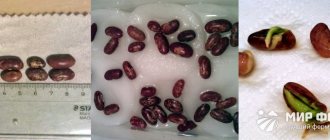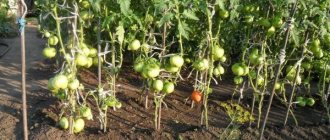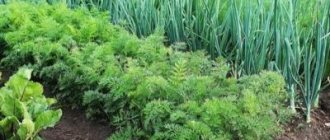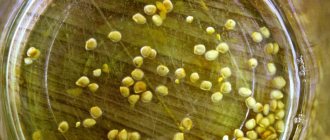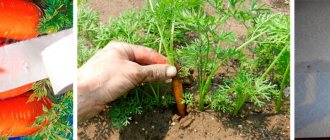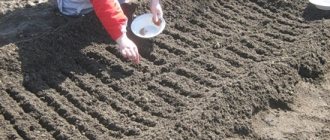What is the germination capacity of this vegetable?
Before growing vegetable seedlings for planting, you need to know how long it takes for eggplant seeds to germinate. This plant is quite whimsical. It will take a lot of effort to grow it. Plant seeds need from 10 to 25 days to germinate, when using seeds with a shelf life of 2-4 years and creating comfortable conditions for them.
To check the material for sowing for germination you need:
- Take 10 grains and place them in a cloth bag.
- Dip in warm water and place on a flat surface and leave for 3-4 days. Maintaining the temperature around 30 °C.
- Remove and inspect the seeds.
If more than five seeds have sprouted, then the material is suitable for planting in the ground.
Germination test
How to plant seeds correctly
Tomatoes should be sown in light nutrient soil. The planting container must be provided with a drainage system.
The seeds are placed at a distance of several centimeters from each other. There is no need to plant deep. Holes 1.5 cm deep are enough. After sowing, you need to carefully water it, cover the container with polyethylene or glass and place it in a warm place until shoots appear.
Read more about different methods of planting tomatoes and caring for seedlings in our article “Planting tomatoes for seedlings, growing tomatoes at home.”
Main factors affecting germination
The germination time of eggplant seeds depends on a number of factors:
- optimal sowing time;
- seeding rate per unit area and planting depth no more than 2 cm;
- correct temperature regime (not lower than +25 °C; as sprouts begin to appear, reduce the indicator to 15 °C).
Advice! When growing crops, it is important to take into account the influence of external factors on seed germination in order to obtain friendly shoots, strong plants and a harvest of good quantity and quality.
How to choose the right landing time
Tomatoes should be planted on the waxing moon. This time is considered the most successful for the procedure. It is not recommended to plant on a dying moon, but, as a last resort, you can sow on these days. But you can’t sow tomatoes on the full moon or new moon.
Read about when to plant seeds according to the lunar calendar in our article “Lunar sowing calendar for gardeners and gardeners for 2020.”
How to increase germination
The most important thing for successful and rapid germination of vegetable seedlings:
- compliance with temporary disembarkation deadlines;
- using only soil suitable for this plant;
- competent choice of seeds;
- not too deep deepening of the seed;
- moderate and timely watering;
- correct temperature conditions and optimal lighting.
Attention! The germination of seed is zero if it was kept in a place without access to oxygen during storage.
How to improve seed germination
How does temperature affect the similarity of tomato seeds?
Plants love warmth. And tomatoes are no exception. In order for seeds planted in the ground to grow, they need to be provided with a sufficiently high temperature.
The fewer degrees the thermometer shows, the slower the grains germinate. The same goes for temperature changes. They negatively affect the rate of emergence of seedlings.
In an ordinary apartment with central heating, it is quite problematic to regulate the desired temperature level.
But, if you have such an opportunity, then provide the crops with a temperature of 25 degrees. This is the optimal mode for the fastest germination of tomato grains. And the greatest effect will be if you create a greenhouse effect for the crops. This is very easy to do; you just need to cover the container with the planted grains with cling film or a plastic bag.
ON A NOTE. In an ordinary apartment, the best place for sowing tomatoes that have not yet sprouted is under the radiator. But we must not forget to maintain the required level of humidity in the greenhouse.
How many days after sowing do seedlings appear?
Many beginning gardeners are interested in how long it takes for eggplants to sprout. While the seeds are at rest, the vital processes in them proceed unnoticed. But as soon as they get into comfortable conditions, the grains immediately become active and begin to germinate intensively, giving life to a new plant.
When growing, it is important to remember that each crop has its own germination time, so there is no need to rush to throw away the soil three days after sowing eggplants. If you sow dry, unprepared seeds, you can wait up to 25 days or even longer for results.
Therefore, all experienced gardeners before planting recommend carrying out a number of measures with seed material aimed at reducing the germination period to 7 days, as well as eliminating possible plant infection.
Vegetable sprouts
How does the quality of seed material affect
In fact, the quality of the seed is the decisive factor. If the grains you are going to plant are expired or of poor quality, then nothing you do will help them sprout faster. On the other hand, healthy and genetically strong grains will germinate even under the most unfavorable conditions.
Unfortunately, the quality of purchased seeds cannot be guaranteed. There is always a chance to buy dummies, “dormant” grains, etc. But a number of simple rules will help minimize the chance of buying low-quality seeds:
- Buy only proven seed material from reliable manufacturers. This way there is less chance of running into counterfeit products.
- Do not store seeds in the refrigerator. So you only drive them into hibernation.
- Do not buy seeds that have expired. Seed storage duration is 5 years. In rare cases, there are varieties that can retain their properties for up to a decade and a half, but this is usually written on the packaging. If there are no such notes, then the variety is standard with a standard shelf life.
ON A NOTE. That is why do not try to buy seeds for future use. Take as many packages as you can sow. Every year the germination of the material gets worse and worse. In addition, new varieties and hybrids with improved characteristics appear every year.
Seedlings grown from high-quality seed material tolerate picking and transplanting better and produce a better harvest.
How to speed up the process of seed germination
Preparing eggplant seeds before sowing will speed up the appearance of sprouts. It includes several events, each of which has its own specifics.
Soak
To get a good harvest of vegetables, the seeds need to be soaked before planting. This procedure will also protect the crop from diseases and enrich it with microelements.
For this you will need:
- deep and wide capacity;
- cotton fabric;
- pure water.
The seeds should be placed between a cloth dipped in water. Fill the container with liquid so that the fabric is slightly damp, otherwise there is a chance of spoiling the seed due to lack of air and excess moisture. Send the dishes to a warm and unlit place for 2 days. This will allow you to obtain specimens for seedlings of good quality and sowing in open soil.
On a note! The biggest difficulty in soaking is that you need to change the water every 4 hours, slightly stirring the material. As a rule, the procedure is stopped when all the grains have swelled and a few have hatched.
Soaking the seeds
Stimulation
Using the stimulation method reduces the interval from sowing to the first shoots to several days.
Common mistakes, or why tomatoes don't sprout
Seeds may not germinate for many reasons.
The most common mistakes are:
- using expired seed (homemade or store-bought), it contains many empty specimens, and these do not hatch;
- dry cultivation without prior soaking or germination;
- use of excessively dense soil;
- germination in pure peat, it is not suitable for tomatoes in terms of pH level;
- unsuitable temperature, germination in cold conditions;
- improper watering: both lack of moisture and systematic overwatering are equally destructive for tomatoes;
- the depth of the holes is too deep when planting.
Obtaining healthy and strong tomato seedlings is the key to a good harvest of a tasty and healthy vegetable. This process begins with seed germination. Therefore, it is so important to comply with all conditions, otherwise the grains will not germinate or the shoots will appear very late, which will significantly delay the harvest.
Why grains don’t germinate for a long time and how to speed up the time
The period from the beginning of germination to the transformation of the seedling into an independent organism is considered the most vulnerable in the life of the plant. Any adverse effect can cause the death of seeds that begin to hatch.
Improper watering, poor-quality seeds, contaminated soil are the main reasons that lead to grains not germinating for a long time. Problems that arise are easier to prevent than to fix. At the same time, you not only need to know when eggplants sprout and on what day the sprouts appear, but also analyze the reason for the failure and take into account all the mistakes in the future.
Improper watering
One of the main steps to achieve good seed germination is proper and timely watering. Since waterlogging of the soil in combination with low temperatures can lead to rotting of seeds even at the optimal sowing depth. Eggplants also react extremely painfully to a lack of moisture, so it is important not to let the soil dry out.
It is better to moisten the soil from a sprayer, so as not to wash out or further deepen seeds that have not yet hatched, or pointwise into the furrows as the top layer of the substrate dries.
On a note! Water for irrigation should be settled for at least 24 hours and warm (20-25 ° C).
Watering rules
Poor quality seed material
One of the reasons why seeds do not germinate is unsuitable planting material. When purchasing grains, there is a risk of receiving a fake or expired product. Such seed material has poor germination and even after special treatment will not give the expected result.
To avoid this, you need to buy seeds only in a specialized store that offers a wide selection of products with a quality guarantee. At the same time, be sure to check the expiration date of the product indicated on the packaging. When planting, use only the freshest possible material that is no more than 2 years old; old material will not sprout.
Advice! When buying seed, it is better to give preference to varieties bred specifically for cultivation in specific climatic conditions.
Planting material
Errors when sowing
Often crop seeds do not germinate due to improper planting. If, when sowing, they are deeply buried in the ground, this may cause them to not hatch. It is important not to forget that the optimal depth for planting grains is 1.5-2 cm.
Sowing rules
Incorrect temperature
If the temperature in the room with the seedlings is below +15 °C, then the emergence of sprouts within the scheduled time frame may not be expected. It's too cold for plants. The optimal temperature for rapid seed germination is considered to be +25 °C. In such conditions, seedlings will appear after 7-10 days.
With the appearance of the first shoots, you need to move the containers with the seedlings to a sunny and warm windowsill and lower the temperature to +16 °C during the day, and at night to +12 °C, so that the root system develops better and the seedlings are stocky.
Optimal temperature for seed germination
Taking into account all the recommendations and following the rules, you can be sure that the effort spent on germinating eggplant seeds will be more than justified, and a good harvest of healthy vegetables will not be long in coming.
What determines the speed of germination?
Tomato seeds germinate well, and their germination time is directly related to temperature.
Germination can be slowed down by improper sowing, care, and poor quality of planting material.
Age
It is best to sow not fresh tomato seeds for seedlings, but 2-3 year old ones. They are considered suitable if 5 out of 10 grains germinate, that is, 50%.
Gardeners will find the following information useful:
- with proper storage, tomatoes germinate well for 6-8 years;
- the expiration date indicated on the label of well-known brands is usually underestimated;
- planting material not kept in ideal conditions will sprout in a maximum of 4 or 5 years;
- You can also sow 10-year-old seeds in large quantities - when treated with stimulants, some grains hatch.
Storage
To preserve tomato planting material at home longer, you need to pay attention to 4 factors:
- Hermetically sealed packaging (foil or glass resealable container).
- Storage temperature is 8-12° C. The upper part of the refrigerator door is ideal (seed germination time is 7-8 years).
- Dryness.
- Lack of light.
But if all storage recommendations are followed, tomatoes do not always sprout well. There are other factors that affect the germination of planting material.
Temperature
How many days it takes for tomato seeds to germinate depends on the content:
| temperature, °C: | 28-32 | 24-26 | 20-23 | 18 |
| germination time, days: | 3-5 | 6-8 | 7-10 | 14 and more |
We are talking about high-quality, properly prepared and sown planting material. Deviations are possible depending on the variety and age of the seeds.
Temperatures below 18° C are unacceptable. The best seedlings are those that hatch within a week at 25° C.
Reasons for delayed emergence
Potatoes react sharply to negative changes in growing conditions. Severe temperature changes, frost, lack of moisture or nutrients can cause a delay in the appearance of sprouts, stunted growth or cessation of bush development. Vegetable grower mistakes also lead to a lack of seedlings. There are several reasons why potatoes do not sprout.
Weather
After planting, tubers react sharply to all unfavorable environmental changes. Potatoes may not germinate well for the following reasons:
- A sharp drop in temperature or frost destroys plant tissues and causes cold burns on buds and immature sprouts. Negative changes occur especially quickly against the background of a deficiency of nutrients in the soil.
- Strong soil moisture and prolonged rains immediately after planting provoke putrefactive processes on tubers. In damp soil, the respiration processes of potatoes are disrupted. Due to lack of oxygen, it rots.
- If there is a lack of moisture, the planted potatoes do not develop. In drought conditions, the development of vegetative organs is slowed down.
Failure to comply with landing conditions
Sometimes potatoes do not sprout, but the tubers in the ground still develop and grow. This happens when the planting is too deep. If the soil on the site is loamy, planting is done to a depth of 7 to 8 cm. Loose sandy loam or peat soil requires planting tubers 10-12 cm from the top level. A thicker layer of soil over the sprouts makes it more difficult for them to germinate.
To protect hatched sprouts from low air temperatures, planting is carried out after the final warm weather sets in. To be safe, in regions with a cool climate, at first the sprouts are covered with agrofibre at night.
Poor quality planting material
After preparing the bed, the seed material is inspected, selecting only good tubers for planting. Small specimens without eyes or with signs of damage or rot are subject to rejection. Also, you should not plant potatoes with thin, weak sprouts or those that have been treated with potent fungicidal preparations. Small potatoes produce weak sprouts. Therefore, tubers weighing less than 40 g are not used for planting.
Important! Large potatoes are used as seeds. Such tubers contain a large supply of nutrients to ensure the development of young shoots.
Diseases
Sometimes the cause of poor germination is potato diseases. Seed tubers may be infected with black scab, late blight, potato canker, gray mold or other diseases. If the spring is cold and rainy, fungal diseases develop quickly. Pathogenic microorganisms spread with rain or dew.
To prevent diseases from developing, potatoes are planted in compliance with the rules of crop rotation. Pre-planting treatment of tubers also reduces the likelihood of diseases. To protect the soil from pathogenic microflora after harvesting, green manure is planted on it.
Potato ripening period from planting to harvest: growing season
Pests
Sometimes planted tubers are eaten by insects while still in the soil. Potatoes attract May beetle larvae, wireworms, and mole crickets. To combat them in the fall, the soil is dug up to the depth of a spade bayonet. A week before the planned planting date, mole crickets and other insects are caught on the site using beer traps. At the time of planting, crushed eggshells are added to the prepared hole. During the period of active growth of bushes, the soil under them is mulched with onion peels.
How to eliminate delays in plant development
Potatoes don't sprout - what to do? Even if the potatoes have already been planted, you can still improve the conditions for their germination: start watering and fertilizing correctly. Secondary planting of tubers is also allowed, although it takes a lot of time and effort and does not always eliminate the reason why potatoes do not sprout.
It’s better to start actively fertilizing the soil, hilling it up, and covering the sprouts with a tent made of special material.
Covering the culture is especially important. Plantings should be covered at night, before the onset of cold weather in the evening.
This action is relevant in spring and during the cold periods of summer. Shelter reduces the risk of sprouts dying due to frost and allows them to develop normally even in very cold spring nights.
Don't overdo it with fertilizer. It is enough to water once every two weeks with fertilizers dissolved in water. In this case, the water for dilution should be warm; it should not be poured too much in one place.
All weeds should be removed from the soil - they can take away nutrients and hinder the development of the plant. If treatment against parasites and diseases has not yet been carried out, this should be provided. While the sprouts have not yet sprouted or have not reached the “age” of 2 weeks, you can safely cultivate the soil.
Please note: Treatment with special compounds must be carried out exclusively in a protective suit. It is necessary to protect the respiratory tract, eyes, skin... The last resort is digging up the beds and removing bad tubers
Unsprouted, rotten and pest-infested nodules will only harm neighbors by rotting. If the seeds were planted too close, some of them will have to be removed and others discharged. Then development can begin with renewed vigor
The last resort is digging up the beds and removing bad tubers. Unsprouted, rotten and pest-infested nodules will only harm neighbors by rotting. If the seeds were planted too close, some of them will have to be removed and others discharged. Then development can begin with renewed vigor.
If even after these measures the potatoes have not sprouted, what should I do? Completely change the seed material. Potatoes that do not sprout even after proper planting with constant care are simply defective and unviable.
Proper planting and care are the key to rapid germination
In order for tomato seeds to germinate quickly, you need to follow some rules for planting and further care, which include:
- Soil preparation.
- Maintaining seed placement depth.
- Maintaining soil moisture.
- Ensuring optimal temperature for germination.
Soil preparation
Tomatoes do not germinate well in heavy soils, and in too light soils they develop and grow poorly. To ensure that tomato seeds germinate quickly and future seedlings have enough nutrients for the growing season, it is advisable to prepare the soil for seedlings yourself.
To do this, sand, humus (or vegetable compost), peat and garden soil are prepared in equal proportions in the fall. Before planting, the prepared soil mixture is disinfected, if necessary, fertilizer is applied, warmed and moistened.
About soil and air temperature
The optimal temperature for germination is considered to be +25 degrees. To ensure this temperature, seedling containers in apartment conditions are placed closer to central heating sources or placed in kitchens near stoves.
If seeds are sown for seedlings directly in greenhouses, the room is heated in advance, and the soil is heated by adding organic matter, which releases heat when decomposed. The day before sowing, the beds in the greenhouse are poured with boiling water and covered with film. In an apartment, you can warm up the soil using a radiator by placing containers with sown tomatoes on it.
Planting depth
One of the most common mistakes when sowing tomato seeds is planting them too deep in the soil. To ensure that tomato seeds germinate quickly and uniformly, they should be planted to a depth of 1 centimeter.
Sowing is carried out in furrows with a distance between grains of 2 - 3 cm, between rows 5 - 7 cm. The furrows are covered with soil and loosely compacted.
Humidity
Until the seeds germinate, it is necessary to keep the soil mixture constantly moist. The earth should not dry out, otherwise weak seedlings will not be able to break through to the light. Since containers with tomatoes are kept at high temperatures until germination, drying out of the soil is a common phenomenon.
To avoid this, containers are covered with glass, translucent film or plastic caps cut from bottles. A greenhouse-like microclimate is created inside the container, with high humidity and stable temperature.
Once a day, the caps (film, glass) are removed for ventilation, and the soil is moistened if necessary using a hand sprayer.
This is interesting: Soda for tomato seedlings: in general terms
Caring for potatoes after germination
If the potatoes sprout well, the first thing to do is to provide regular watering, 2-3 times a season during dry summers. Moisture is necessary for it to bloom and the fruits to begin to ripen. Twice a summer, hill up the plant crop as it grows and loosen the soil. This is necessary so that the underground stems are better strengthened and second-order tubers can already appear on them.
If weeds grow on the ridge, remove them immediately. Firstly, they interfere with the full development of the root system, and secondly, they consume nutrients from the soil necessary for the ripening of tubers. Be sure to inspect adult bushes regularly. If pests appear, destroy them with special means against adult insects and their larvae.
Germination of petunia in open ground
The easiest way to grow these flowers is direct planting in open ground. This method is perfect for areas with mild climatic conditions; in harsh climates, the plant will die due to insufficient temperature. Most often, sowing is carried out in April, but to a greater extent you need to focus on weather conditions and air temperature. Small-flowered varieties take root best in the soil. The soil can also be prepared before planting.
After the seeds germinate, they need to be fed and watered. If desired, you can pour charcoal under the bushes.
When should you start worrying?
If the seeds have not even begun to hatch after 12–17 days, then the gardener should worry. It would be advisable to “dig” a small area to see with your own eyes the degree of development of the sprouts. If there are no signs of germination, the seeds need to be replanted. Of course, you first need to analyze the situation and answer the question: “Why didn’t the seeds germinate?”
If you comply with all the necessary requirements for the process of seed preparation and sowing, set out in the article, then you do not need to worry about the emergence of seedlings.
If you find an error, please select a piece of text and press Ctrl+Enter.


